Report on Strategic Management 2022
VerifiedAdded on 2022/09/17
|6
|1441
|20
AI Summary
Contribute Materials
Your contribution can guide someone’s learning journey. Share your
documents today.

Strategic Management
Secure Best Marks with AI Grader
Need help grading? Try our AI Grader for instant feedback on your assignments.
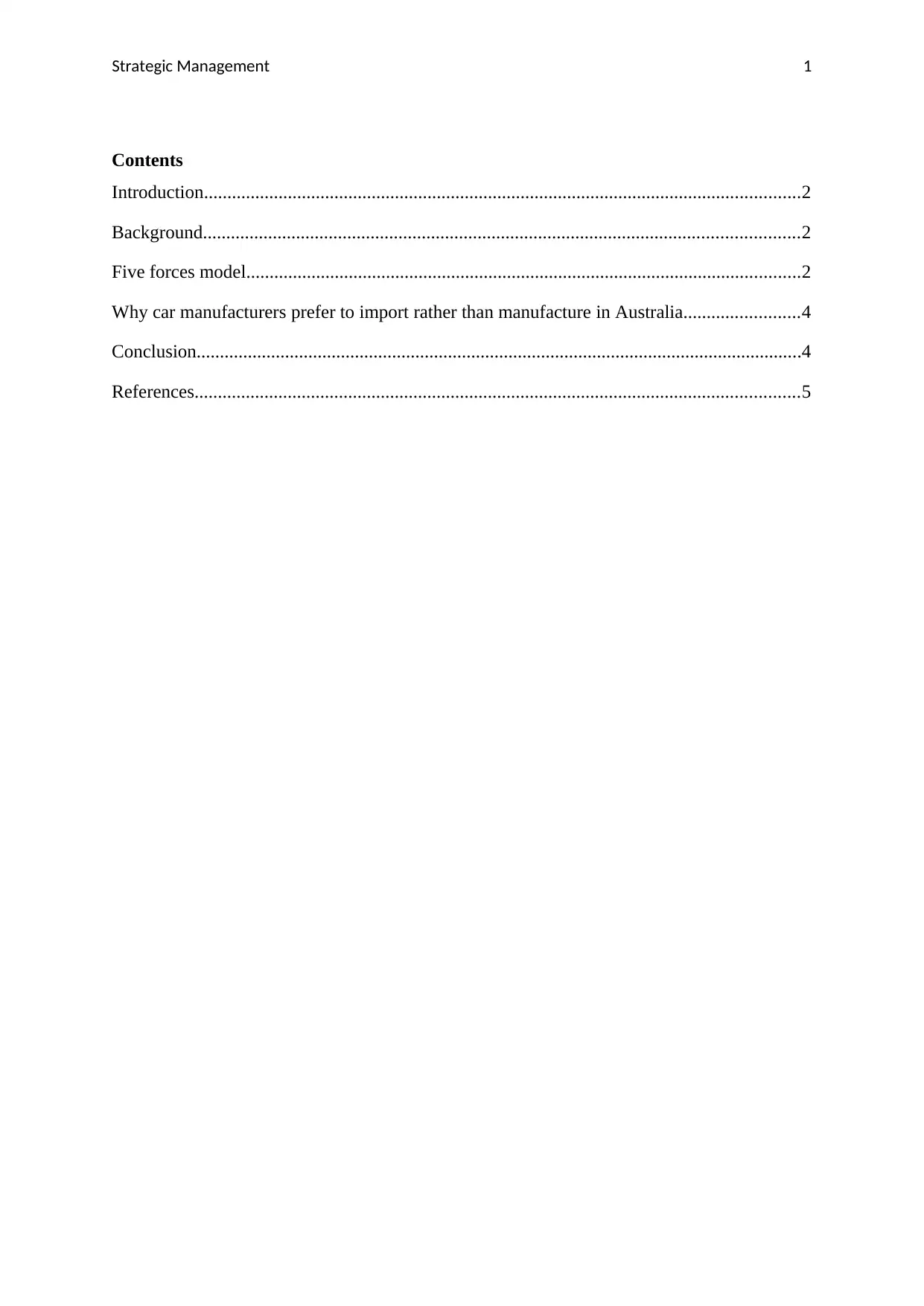
Strategic Management 1
Contents
Introduction................................................................................................................................2
Background................................................................................................................................2
Five forces model.......................................................................................................................2
Why car manufacturers prefer to import rather than manufacture in Australia.........................4
Conclusion..................................................................................................................................4
References..................................................................................................................................5
Contents
Introduction................................................................................................................................2
Background................................................................................................................................2
Five forces model.......................................................................................................................2
Why car manufacturers prefer to import rather than manufacture in Australia.........................4
Conclusion..................................................................................................................................4
References..................................................................................................................................5
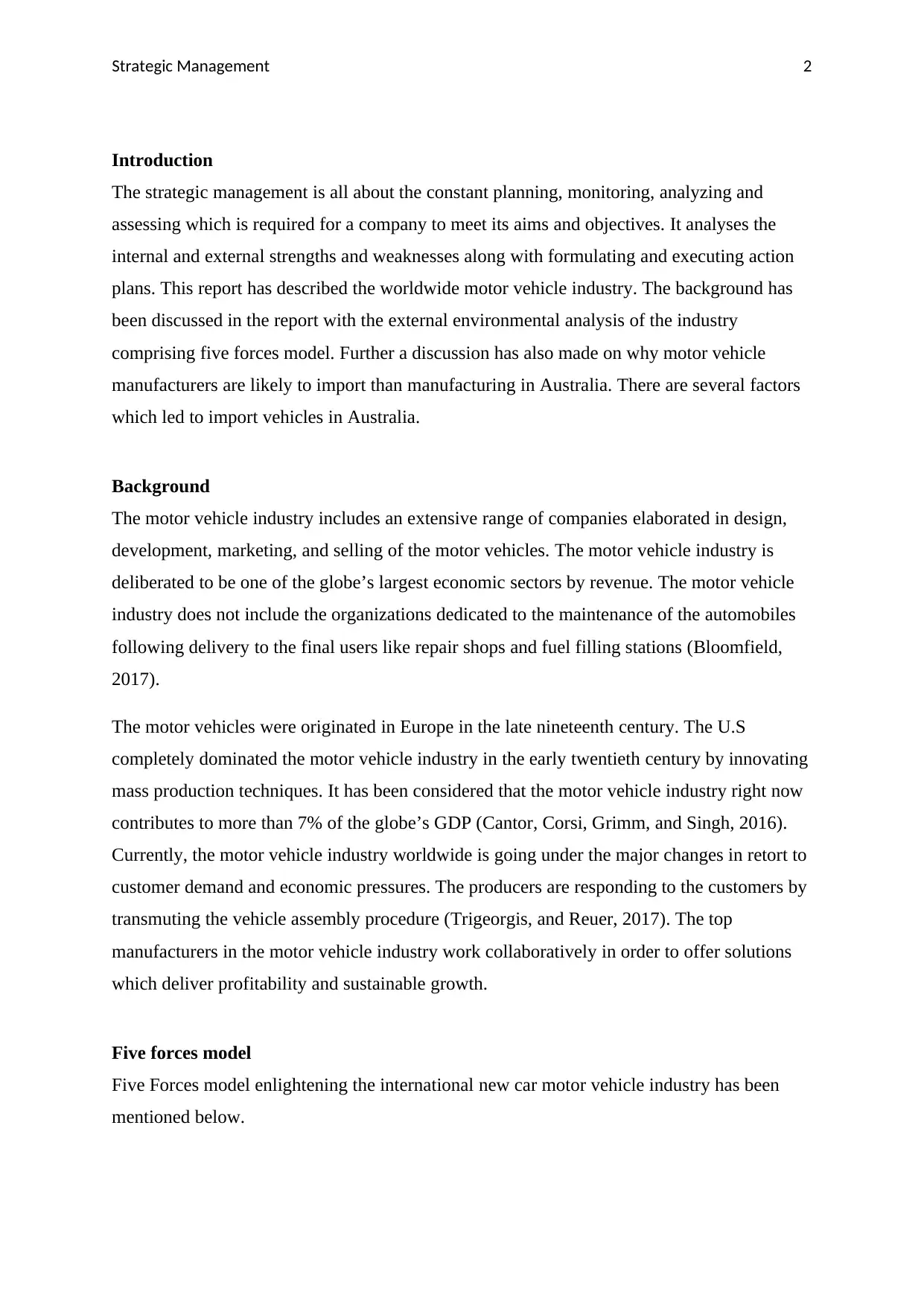
Strategic Management 2
Introduction
The strategic management is all about the constant planning, monitoring, analyzing and
assessing which is required for a company to meet its aims and objectives. It analyses the
internal and external strengths and weaknesses along with formulating and executing action
plans. This report has described the worldwide motor vehicle industry. The background has
been discussed in the report with the external environmental analysis of the industry
comprising five forces model. Further a discussion has also made on why motor vehicle
manufacturers are likely to import than manufacturing in Australia. There are several factors
which led to import vehicles in Australia.
Background
The motor vehicle industry includes an extensive range of companies elaborated in design,
development, marketing, and selling of the motor vehicles. The motor vehicle industry is
deliberated to be one of the globe’s largest economic sectors by revenue. The motor vehicle
industry does not include the organizations dedicated to the maintenance of the automobiles
following delivery to the final users like repair shops and fuel filling stations (Bloomfield,
2017).
The motor vehicles were originated in Europe in the late nineteenth century. The U.S
completely dominated the motor vehicle industry in the early twentieth century by innovating
mass production techniques. It has been considered that the motor vehicle industry right now
contributes to more than 7% of the globe’s GDP (Cantor, Corsi, Grimm, and Singh, 2016).
Currently, the motor vehicle industry worldwide is going under the major changes in retort to
customer demand and economic pressures. The producers are responding to the customers by
transmuting the vehicle assembly procedure (Trigeorgis, and Reuer, 2017). The top
manufacturers in the motor vehicle industry work collaboratively in order to offer solutions
which deliver profitability and sustainable growth.
Five forces model
Five Forces model enlightening the international new car motor vehicle industry has been
mentioned below.
Introduction
The strategic management is all about the constant planning, monitoring, analyzing and
assessing which is required for a company to meet its aims and objectives. It analyses the
internal and external strengths and weaknesses along with formulating and executing action
plans. This report has described the worldwide motor vehicle industry. The background has
been discussed in the report with the external environmental analysis of the industry
comprising five forces model. Further a discussion has also made on why motor vehicle
manufacturers are likely to import than manufacturing in Australia. There are several factors
which led to import vehicles in Australia.
Background
The motor vehicle industry includes an extensive range of companies elaborated in design,
development, marketing, and selling of the motor vehicles. The motor vehicle industry is
deliberated to be one of the globe’s largest economic sectors by revenue. The motor vehicle
industry does not include the organizations dedicated to the maintenance of the automobiles
following delivery to the final users like repair shops and fuel filling stations (Bloomfield,
2017).
The motor vehicles were originated in Europe in the late nineteenth century. The U.S
completely dominated the motor vehicle industry in the early twentieth century by innovating
mass production techniques. It has been considered that the motor vehicle industry right now
contributes to more than 7% of the globe’s GDP (Cantor, Corsi, Grimm, and Singh, 2016).
Currently, the motor vehicle industry worldwide is going under the major changes in retort to
customer demand and economic pressures. The producers are responding to the customers by
transmuting the vehicle assembly procedure (Trigeorgis, and Reuer, 2017). The top
manufacturers in the motor vehicle industry work collaboratively in order to offer solutions
which deliver profitability and sustainable growth.
Five forces model
Five Forces model enlightening the international new car motor vehicle industry has been
mentioned below.
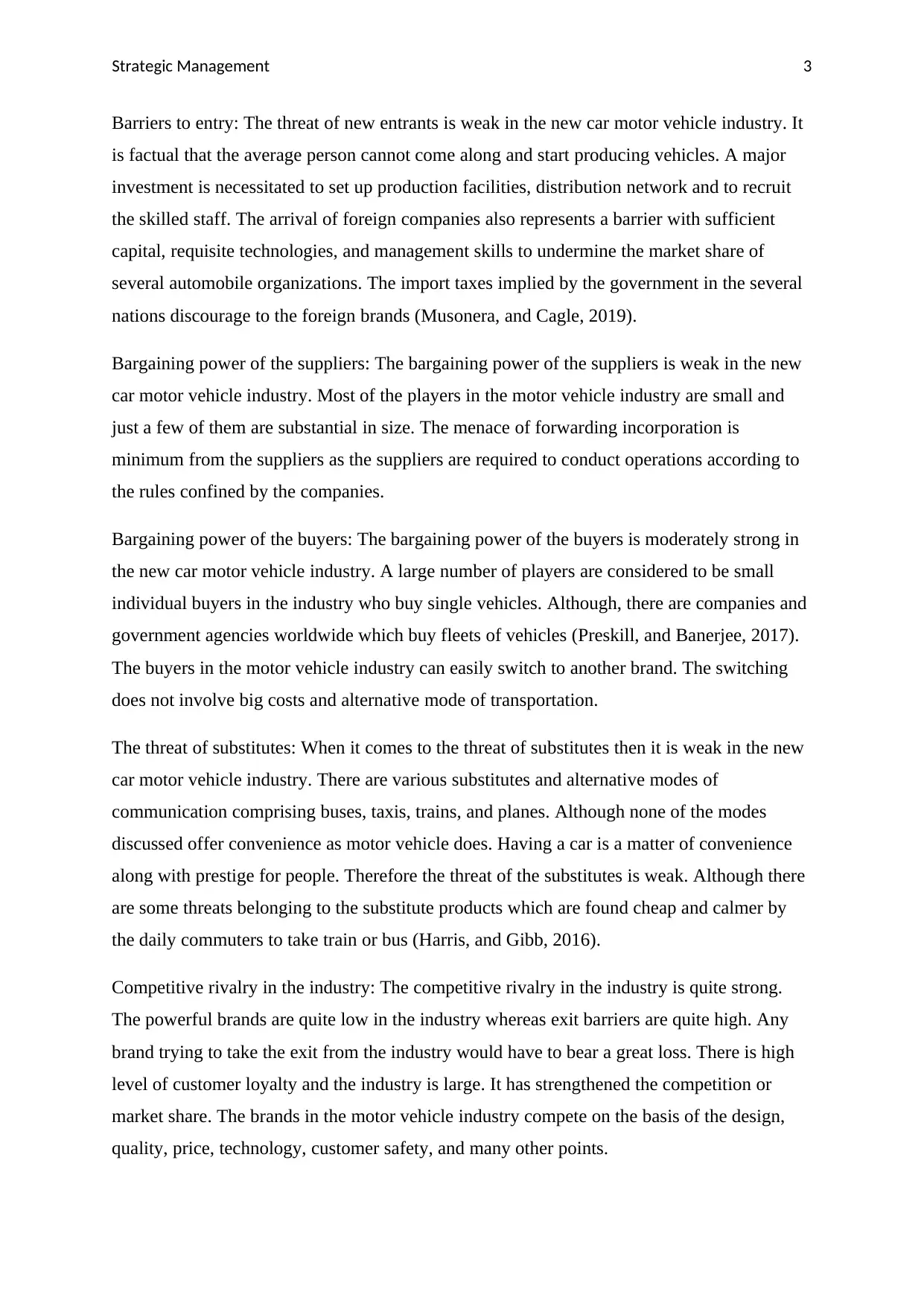
Strategic Management 3
Barriers to entry: The threat of new entrants is weak in the new car motor vehicle industry. It
is factual that the average person cannot come along and start producing vehicles. A major
investment is necessitated to set up production facilities, distribution network and to recruit
the skilled staff. The arrival of foreign companies also represents a barrier with sufficient
capital, requisite technologies, and management skills to undermine the market share of
several automobile organizations. The import taxes implied by the government in the several
nations discourage to the foreign brands (Musonera, and Cagle, 2019).
Bargaining power of the suppliers: The bargaining power of the suppliers is weak in the new
car motor vehicle industry. Most of the players in the motor vehicle industry are small and
just a few of them are substantial in size. The menace of forwarding incorporation is
minimum from the suppliers as the suppliers are required to conduct operations according to
the rules confined by the companies.
Bargaining power of the buyers: The bargaining power of the buyers is moderately strong in
the new car motor vehicle industry. A large number of players are considered to be small
individual buyers in the industry who buy single vehicles. Although, there are companies and
government agencies worldwide which buy fleets of vehicles (Preskill, and Banerjee, 2017).
The buyers in the motor vehicle industry can easily switch to another brand. The switching
does not involve big costs and alternative mode of transportation.
The threat of substitutes: When it comes to the threat of substitutes then it is weak in the new
car motor vehicle industry. There are various substitutes and alternative modes of
communication comprising buses, taxis, trains, and planes. Although none of the modes
discussed offer convenience as motor vehicle does. Having a car is a matter of convenience
along with prestige for people. Therefore the threat of the substitutes is weak. Although there
are some threats belonging to the substitute products which are found cheap and calmer by
the daily commuters to take train or bus (Harris, and Gibb, 2016).
Competitive rivalry in the industry: The competitive rivalry in the industry is quite strong.
The powerful brands are quite low in the industry whereas exit barriers are quite high. Any
brand trying to take the exit from the industry would have to bear a great loss. There is high
level of customer loyalty and the industry is large. It has strengthened the competition or
market share. The brands in the motor vehicle industry compete on the basis of the design,
quality, price, technology, customer safety, and many other points.
Barriers to entry: The threat of new entrants is weak in the new car motor vehicle industry. It
is factual that the average person cannot come along and start producing vehicles. A major
investment is necessitated to set up production facilities, distribution network and to recruit
the skilled staff. The arrival of foreign companies also represents a barrier with sufficient
capital, requisite technologies, and management skills to undermine the market share of
several automobile organizations. The import taxes implied by the government in the several
nations discourage to the foreign brands (Musonera, and Cagle, 2019).
Bargaining power of the suppliers: The bargaining power of the suppliers is weak in the new
car motor vehicle industry. Most of the players in the motor vehicle industry are small and
just a few of them are substantial in size. The menace of forwarding incorporation is
minimum from the suppliers as the suppliers are required to conduct operations according to
the rules confined by the companies.
Bargaining power of the buyers: The bargaining power of the buyers is moderately strong in
the new car motor vehicle industry. A large number of players are considered to be small
individual buyers in the industry who buy single vehicles. Although, there are companies and
government agencies worldwide which buy fleets of vehicles (Preskill, and Banerjee, 2017).
The buyers in the motor vehicle industry can easily switch to another brand. The switching
does not involve big costs and alternative mode of transportation.
The threat of substitutes: When it comes to the threat of substitutes then it is weak in the new
car motor vehicle industry. There are various substitutes and alternative modes of
communication comprising buses, taxis, trains, and planes. Although none of the modes
discussed offer convenience as motor vehicle does. Having a car is a matter of convenience
along with prestige for people. Therefore the threat of the substitutes is weak. Although there
are some threats belonging to the substitute products which are found cheap and calmer by
the daily commuters to take train or bus (Harris, and Gibb, 2016).
Competitive rivalry in the industry: The competitive rivalry in the industry is quite strong.
The powerful brands are quite low in the industry whereas exit barriers are quite high. Any
brand trying to take the exit from the industry would have to bear a great loss. There is high
level of customer loyalty and the industry is large. It has strengthened the competition or
market share. The brands in the motor vehicle industry compete on the basis of the design,
quality, price, technology, customer safety, and many other points.
Secure Best Marks with AI Grader
Need help grading? Try our AI Grader for instant feedback on your assignments.
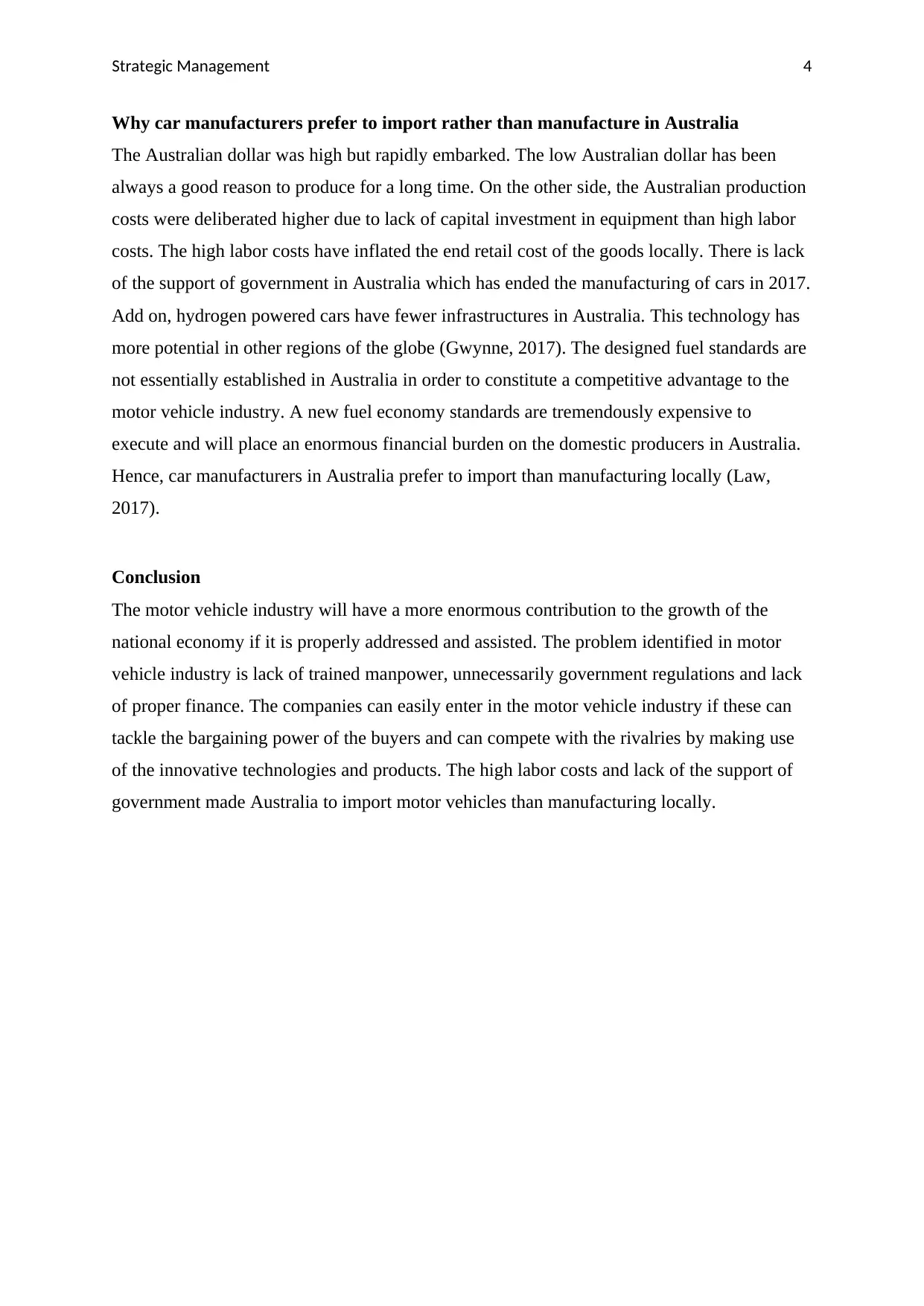
Strategic Management 4
Why car manufacturers prefer to import rather than manufacture in Australia
The Australian dollar was high but rapidly embarked. The low Australian dollar has been
always a good reason to produce for a long time. On the other side, the Australian production
costs were deliberated higher due to lack of capital investment in equipment than high labor
costs. The high labor costs have inflated the end retail cost of the goods locally. There is lack
of the support of government in Australia which has ended the manufacturing of cars in 2017.
Add on, hydrogen powered cars have fewer infrastructures in Australia. This technology has
more potential in other regions of the globe (Gwynne, 2017). The designed fuel standards are
not essentially established in Australia in order to constitute a competitive advantage to the
motor vehicle industry. A new fuel economy standards are tremendously expensive to
execute and will place an enormous financial burden on the domestic producers in Australia.
Hence, car manufacturers in Australia prefer to import than manufacturing locally (Law,
2017).
Conclusion
The motor vehicle industry will have a more enormous contribution to the growth of the
national economy if it is properly addressed and assisted. The problem identified in motor
vehicle industry is lack of trained manpower, unnecessarily government regulations and lack
of proper finance. The companies can easily enter in the motor vehicle industry if these can
tackle the bargaining power of the buyers and can compete with the rivalries by making use
of the innovative technologies and products. The high labor costs and lack of the support of
government made Australia to import motor vehicles than manufacturing locally.
Why car manufacturers prefer to import rather than manufacture in Australia
The Australian dollar was high but rapidly embarked. The low Australian dollar has been
always a good reason to produce for a long time. On the other side, the Australian production
costs were deliberated higher due to lack of capital investment in equipment than high labor
costs. The high labor costs have inflated the end retail cost of the goods locally. There is lack
of the support of government in Australia which has ended the manufacturing of cars in 2017.
Add on, hydrogen powered cars have fewer infrastructures in Australia. This technology has
more potential in other regions of the globe (Gwynne, 2017). The designed fuel standards are
not essentially established in Australia in order to constitute a competitive advantage to the
motor vehicle industry. A new fuel economy standards are tremendously expensive to
execute and will place an enormous financial burden on the domestic producers in Australia.
Hence, car manufacturers in Australia prefer to import than manufacturing locally (Law,
2017).
Conclusion
The motor vehicle industry will have a more enormous contribution to the growth of the
national economy if it is properly addressed and assisted. The problem identified in motor
vehicle industry is lack of trained manpower, unnecessarily government regulations and lack
of proper finance. The companies can easily enter in the motor vehicle industry if these can
tackle the bargaining power of the buyers and can compete with the rivalries by making use
of the innovative technologies and products. The high labor costs and lack of the support of
government made Australia to import motor vehicles than manufacturing locally.
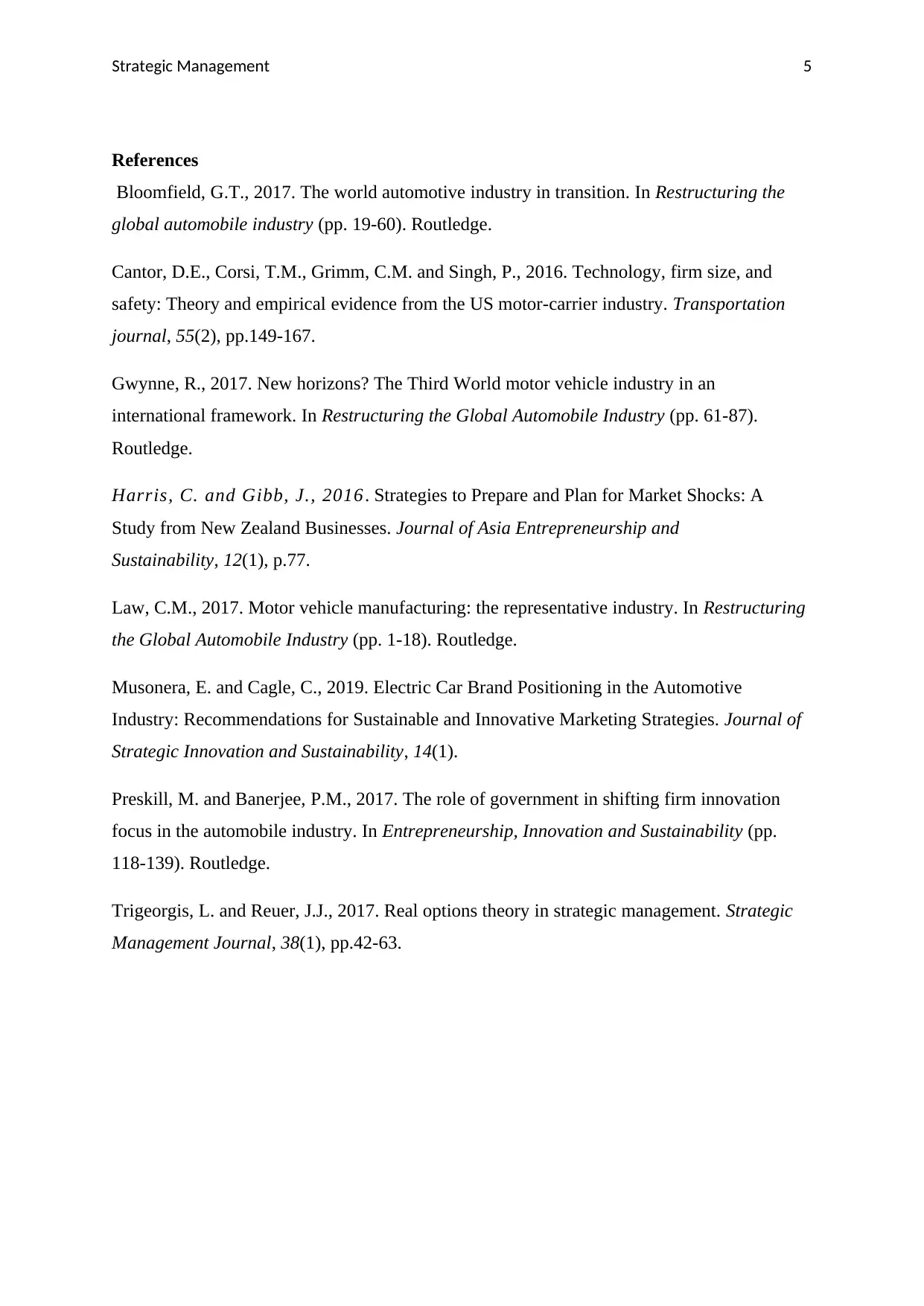
Strategic Management 5
References
Bloomfield, G.T., 2017. The world automotive industry in transition. In Restructuring the
global automobile industry (pp. 19-60). Routledge.
Cantor, D.E., Corsi, T.M., Grimm, C.M. and Singh, P., 2016. Technology, firm size, and
safety: Theory and empirical evidence from the US motor-carrier industry. Transportation
journal, 55(2), pp.149-167.
Gwynne, R., 2017. New horizons? The Third World motor vehicle industry in an
international framework. In Restructuring the Global Automobile Industry (pp. 61-87).
Routledge.
Harris, C. and Gibb, J., 2016. Strategies to Prepare and Plan for Market Shocks: A
Study from New Zealand Businesses. Journal of Asia Entrepreneurship and
Sustainability, 12(1), p.77.
Law, C.M., 2017. Motor vehicle manufacturing: the representative industry. In Restructuring
the Global Automobile Industry (pp. 1-18). Routledge.
Musonera, E. and Cagle, C., 2019. Electric Car Brand Positioning in the Automotive
Industry: Recommendations for Sustainable and Innovative Marketing Strategies. Journal of
Strategic Innovation and Sustainability, 14(1).
Preskill, M. and Banerjee, P.M., 2017. The role of government in shifting firm innovation
focus in the automobile industry. In Entrepreneurship, Innovation and Sustainability (pp.
118-139). Routledge.
Trigeorgis, L. and Reuer, J.J., 2017. Real options theory in strategic management. Strategic
Management Journal, 38(1), pp.42-63.
References
Bloomfield, G.T., 2017. The world automotive industry in transition. In Restructuring the
global automobile industry (pp. 19-60). Routledge.
Cantor, D.E., Corsi, T.M., Grimm, C.M. and Singh, P., 2016. Technology, firm size, and
safety: Theory and empirical evidence from the US motor-carrier industry. Transportation
journal, 55(2), pp.149-167.
Gwynne, R., 2017. New horizons? The Third World motor vehicle industry in an
international framework. In Restructuring the Global Automobile Industry (pp. 61-87).
Routledge.
Harris, C. and Gibb, J., 2016. Strategies to Prepare and Plan for Market Shocks: A
Study from New Zealand Businesses. Journal of Asia Entrepreneurship and
Sustainability, 12(1), p.77.
Law, C.M., 2017. Motor vehicle manufacturing: the representative industry. In Restructuring
the Global Automobile Industry (pp. 1-18). Routledge.
Musonera, E. and Cagle, C., 2019. Electric Car Brand Positioning in the Automotive
Industry: Recommendations for Sustainable and Innovative Marketing Strategies. Journal of
Strategic Innovation and Sustainability, 14(1).
Preskill, M. and Banerjee, P.M., 2017. The role of government in shifting firm innovation
focus in the automobile industry. In Entrepreneurship, Innovation and Sustainability (pp.
118-139). Routledge.
Trigeorgis, L. and Reuer, J.J., 2017. Real options theory in strategic management. Strategic
Management Journal, 38(1), pp.42-63.
1 out of 6
Related Documents
Your All-in-One AI-Powered Toolkit for Academic Success.
+13062052269
info@desklib.com
Available 24*7 on WhatsApp / Email
![[object Object]](/_next/static/media/star-bottom.7253800d.svg)
Unlock your academic potential
© 2024 | Zucol Services PVT LTD | All rights reserved.





